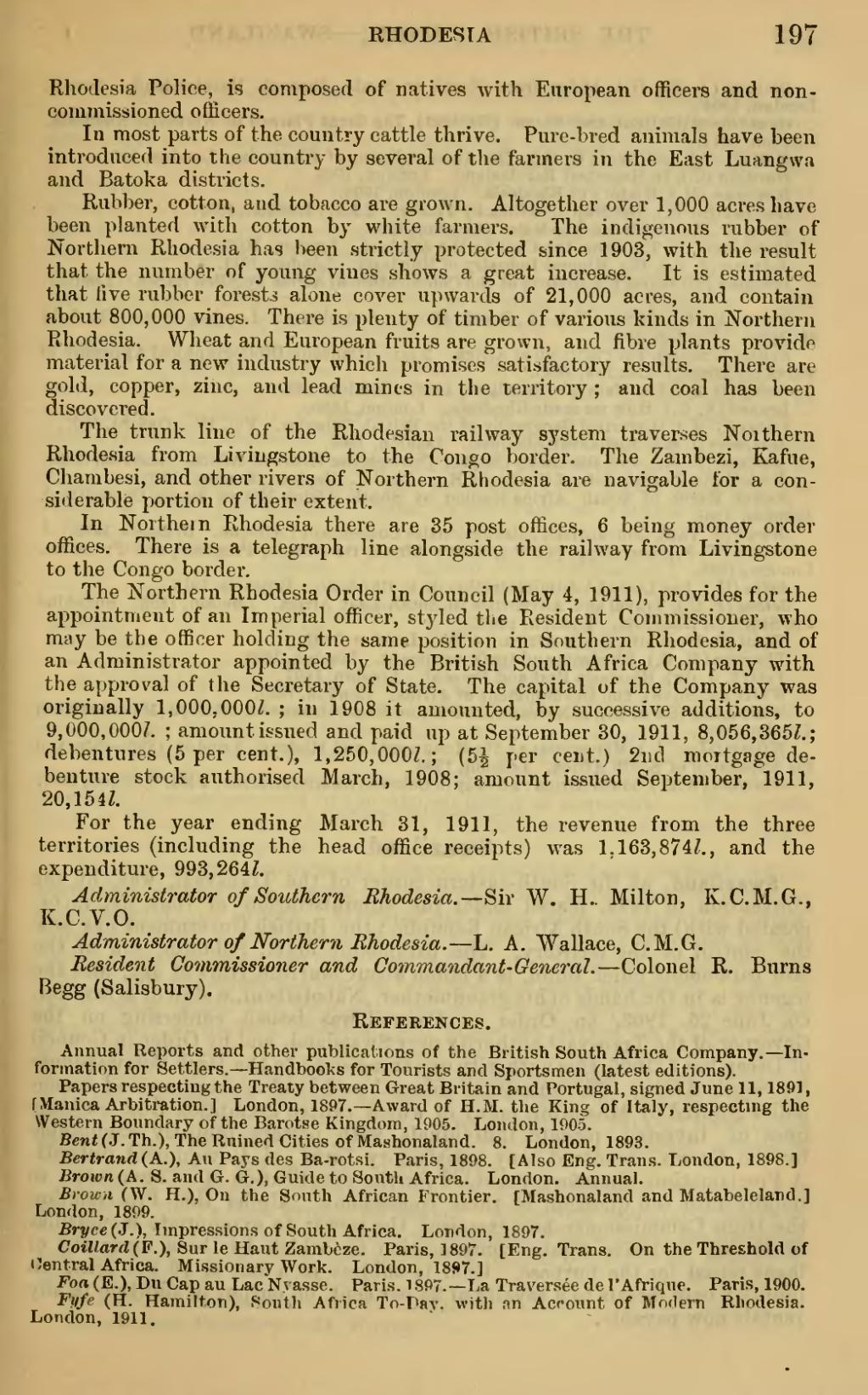RHODESIA 197
Rhodesia Police, is composed of natives with European officers and non- commissioned officers.
In most parts of the country cattle thrive. Pure-bred animals have been introduced into the country by several of the farmers in the East Luangwa and Batoka districts.
Rubber, cotton, and tobacco are grown. Altogether over 1,000 acres have been planted with cotton by white farmers. The indigenous rubber of Northern Rhodesia has been strictly protected since 1903, with the result that the number of young vines shows a great increase. It is estimated that five rubber forests alone cover upwards of 21,000 acres, and contain about 800,000 vines. There is plenty of timber of various kinds in Northern Rhodesia. Wheat and European fruits are grown, and fibre plants provide material for a new industry which promises satisfactory results. There are gold, copper, zinc, and lead mines in the territory ; and coal has been discovered.
The trunk line of the Rhodesian railway system traverses Northern Rhodesia from Livingstone to the Congo border. The Zambezi, Kafue, Chambesi, and other rivers of Northern Rhodesia are navigable for a con- siderable portion of their extent.
In Northern Rhodesia there are 35 post offices, 6 being money order offices. There is a telegraph line alongside the railway from Livingstone to the Congo border.
The Northern Rhodesia Order in Council (May 4, 1911), provides for the appointment of an Imperial officer, styled the Resident Commissioner, who may be the officer holding the same position in Southern Rhodesia, and of an Administrator appointed by the British South Africa Company with the approval of the Secretary of State. The capital of the Company was originally 1,000,000^. ; in 1908 it amounted, by successive additions, to 9,000,000/. ; amount issued and paid up at September 30, 1911, 8,056,365Z.; debentures (5 per cent.), 1,250,000/.; (5^ per cent.) 2iid mortgage de- benture stock authorised March, 1908; amount issued Seiiteniber, 1911, 20,154/.
For the year ending March 31, 1911, the revenue from the three territories (including the head office receipts) was 1.163,874/., and the expenditure, 993,264/.
Administrator of Southern Rhodesia. — Sir W. H.. Milton, K.C.M.G., K.C.V.O.
Administrator of Northern Rhodesia. — L. A. Wallace, C.M.G.
Resident Commissioner and Commandant-General. — Colonel R. Burns Begg (Salisbury).
References.
Annual Reports and other publications of the British South Africa Company.— In- formation for Settlers.— Handbool^s for Tourists and Sportsmen (latest editions).
Papers respecting the Treaty between Great Britain and Portugal, signed June 11, 1891 , [Manica Arbitration.] London, 1897.— Award of H.M. the King of Italy, respecting the Western Boundary of the Barotse Kingdom, 1905. London, 1905.
J5eni(J.Th.), The Ruined Cities of Mashonaland. 8. London, 1893.
Bertrand {K.), Au Pays des Ba-rotsi. Paris, 1898. [Also Eng. Trans. London, 1898.]
Brown (A. S. and G. G.), Guide to South Africa. London. Annual.
Brou-n (W. H.), On the South African Frontier. [Mashonaland and Matabeleland.] London, 1899.
Brt/ce (J.), Impressions of South Africa. London, 1897.
C^oiHarrf ( F. ), SurleHaut Zambcze. Paris, 1897. [Eng. Trans. On the Threshold of I 'entral Africa. Missionary Work. London, 1897.]
Foa (E.), Du Cap au Lac Nyasse. Paris. 1 897.— La Traver.see de I'Afrique. Paris, 1900.
Fi/fe (H. Hamilton), South Africa To-Dav. with an Account of Modern Rhodesia. London, 1911.
